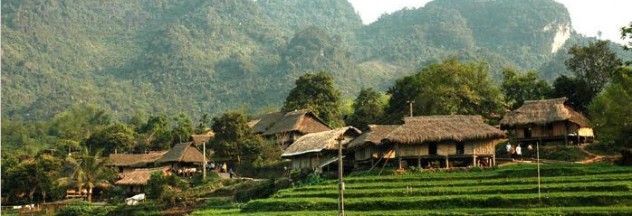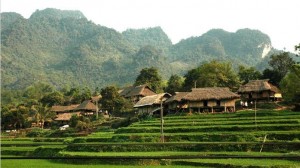Ngoi Village is a small community of 79 households situated in the middle of Hoa Binh Lake reservoir living simply on its own for a very long time. But a community-based tourism project recently introduced the quaint village to the rest of the world and the lives of the local residents are forever changed.
All residents at Ngoi Village are Muong people, one of the earliest settlements of the ethnic group in Hoa Binh Province estimated to be at least 1,000 years old. Ngoi Village is nestled among limestone mountains and abundant with maize fields, orchards, caves and primary forests, holding up to its old name Bua Dam which means “a vast flat area on the mountain that is shaded with abundant tall trees” in the Muong language. Hoa Binh Lake is a man-made lake which is so beautiful that it is being compared to Ha Long Bay, one of Vietnam’s natural wonder. It has over 50 islets of different shapes and sizes which rose from the waters of the lake slowly through time.
The people at Ngoi Village live a very traditional life. They rely on fishing and farming for their main means of livelihood while the others work in the forest looking for edible plants or wood. Children are taught how to herd cows at an early age while still able to play at the foot of the hills. The overall landscape is spectacular. All of the people are naturally friendly as they welcome visitors with much warmth and enthusiasm.
The community-based tourism project which opened Ngoi Village to the world was developed by the Hoa Binh Tourism Investment Joint-Stock Company in 2004. It did so because it saw a huge potential in Ngoi Village in terms of tourism with its breathtaking natural scenery and rich culture. The first phase was assembling homestay accommodations for visitors to stay in and have a firsthand experience of life in the village. Seven families agreed to transform their houses into homestays and were provided with financial support both from the investment company and the provincial government.
The company gave VND200 million (US$8,800) to be paid in five years without interest wherein the money would be used to renovate the existing stilt houses (traditional houses of the Muongs), including building new toilets and buying facilities like heater and hand sinks. A 15-day training was also provided in which the hosts are taught to welcome guests properly and treat them professionally. Keeping the house clean, preparing mattress and blankets, cooking the local dishes and even lifeguard training are among the things the hosts learned. The government gave VND30 million (US$1,300) in cash loan payable in less than five years. Infrastructure and other facilities like a waterpark, kayaking, high-speed cruises and a floating restaurant are among the big investments which entered Ngoi Village.
Guests who chose to stay in homestays for an overnight or two get to help cook the popular dishes at Ngoi such as cha cuon la buoi (grilled pork wrapped in grapefruit leaves), grilled chicken, fried fish and soup with wild plants; and drink the local wine made from rice. They get to witness the famous sunset at Ngoi which is known to be unforgettable for its awesome beauty. An arts programme featuring Muong culture is also performed by the villagers including dancing with bamboo poles and gongs and drinking tube wine.
Visitors also get to meet the village shaman named Bui Van Tan who is highly revered because of his important role of preserving the local culture and history of Ngoi through prayers. He also conducts special ceremonies and teaches the visitors about Muong rituals and wisdom. Mo Muong is one of Hoa Binh’s national intangible heritages which highlights the deep spirituality of the Ngoi people.
The community-based tourism project is based on three issues: “1. Identifying Muong’s cultural identity as an attraction that needs preserving; 2. Enhancing the locals and authority’s awareness about sustainable tourism development without affecting the environment; and 3. Equipping locals with necessary skills so that they can confidently provide services and gain tourism benefits.” And according to the investment company, it has met all of these so far into the project.
But suddenly hurling a long-isolated community into the global civilization could not be without challenges. And in fact, the Department of Culture, Sports and Tourism in Hoa Binh Province has posed some problems in investing in Ngoi Village such as in infrastructure and teaching tourism to the locals who have no idea what it is in the first place and what it will bring to their place, how it will affect their lives. Intensive education and training had to be imbibed within the villagers to help them see the positive impact of tourism, how it will improve their lives economically while preserving the cultural integrity and natural beauty of the place. Fortunately, they soon felt and realized this effect.
Ngoi Village is called “a sleeping beauty who has recently awakened.” With its one-of-a-kind situation of having been disconnected from the world and then suddenly becoming a fast-growing tourist destination, the name is rightly so given. In fact, there are many other “natural wonders” in Ngoi Village which are still generally hidden and just waiting to be discovered.

